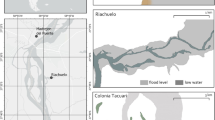Abstract
Macoma nasuta Conrad is primarily a deposit-feeding bivalve sucking the top millimeter of the sediment surface. Growth experiments show that surface sediment supports growth better than detritus falling from the water column. Gut clearance time is between 1 and 9 h (12°C). Fecal pellets are ejected in a regular rhythm. However, the total amount of feces per unit time shows considerable individual variation. Due to sorting in the mantle cavity, about 97% (dry weight) of the surface material is ejected again as pseudofeces. Selectivity by the bivalve is estimated by comparison of particle size and organic composition of sandy and muddy sediments and compared with feces produced by clams fed these sediments. Fecal pellets are in all cases richer in organic components than the sediment, indicating a high degree of selectivity. Ingestion and digestion of small animals (meiofauna) occur, but many of the ingested specimens survive. It is not possible to estimate the assimilation of organic matter by simple difference between the ingested sediment and the ejected feces. The difficulties in calculating energy budgets which arise from selective feeding and associated bacteria are discussed.
Similar content being viewed by others
Literature Cited
Blegvad, H.: Food and conditions of nourishment among the communities of invertebrate animals on the sea bottom in Danish waters. Rep. Dan. biol. Stn 22, 41–78 (1914)
Brinkhurst, R.O., K.E. Chua and N.K. Kaushik: Interspecific interactions and selective feeding by tubificid oligochaetes. Limnol. Oceanogr. 17, 122–133 (1972)
Buchanan, J.B. and M.R. Longbottom: The determination of organic matter in marine muds: The effect of the presence of coal and the routine determination of protein. J. exp. mar. Biol. Ecol. 5, 158–169 (1970)
Calow, P.: Studies on the natural diet of Lymnaea pereger obtusa (Kobelt) and its possible ecological implications. Proc. malac. Soc. Lond. 39, 203–215 (1970)
Condrey, R.E., J.G. Gosselink and H.R. Bennett: Comparison of the assimilation of different diets by Penaeus setiferus and P. aztecus. Fish. Bull. U.S. 70, 1281–1292 (1972)
Currie, R.I.: Pigments in zooplankton feces. Nature, Lond. 193, 956–957 (1962)
Dunnill, R.M. and D.V. Ellis: The distribution and ecology of sub-littoral species of Macoma (bivalvia) off Moresby Island and in Satellite Channel near Victoria, British Columbia. Veliger 12, 207–219 (1969)
Fenchel, T.: Aspects of decomposed food chains in marine benthos. Verh. dt. zool. Ges. 65, 14–23 (1972)
George, J.D.: Organic matter available to the polychaete Cirriformia tentaculata (Montagu) living in an intertidal mud flat. Limnol. Oceanogr. 9, 453–455 (1964)
Golterman, H.L. and R.S. Clymo: Methods for chemical analysis of fresh water. IBP Handbook No. 8, 2nd ed. 166 pp. Oxford and Edinburgh: Blackwell Scientific Publications 1969
Hughes, R.H.: A study of feeding in Scrobicularia plana. J. mar. biol. Ass. U.K. 49, 805–823 (1969)
—: An energy budget for a tidal-flat population of the bivalve Scrobicularia plana (DaCosta). J. Anim. Ecol. 39, 357–381 (1970)
Hylleberg, K.J.: Structure and function of crystalline styles of bivalves. Ophelia 10, 91–108 (1972)
Lorenzen, C.J.: Determination of chlorophyll and pheopigments: spectrophotometric equations. Limnol. Oceanogr. 12, 243–346 (1967)
Mansour, K. and F.G. Zaki: The digestive diverticula of Unio prasidens as organs of secretion. Proc. Egypt. Acad. Sci. 2, 38–44 (1946)
McQuiston, R.W.: Cyclic activity in the digestive diverticula of Lassea rubra (Montagu) (Bivalvia: Eulamellibranchia). Proc. malac. Soc. Lond. 38, 483–492 (1969)
Meadows, P.S. and J.G. Anderson: Micro-organisms attached to marine sand grains. J. mar. biol. Ass. U.K. 48, 161–175 (1968)
Paffenhöfer, G.A. and J.D.H. Strickland: A note on the feeding of Calanus helgolandicus on detritus. Mar. Biol. 5, 97–99 (1970)
Pal, S.G.: The fine structure of the digestive tubule of Mya arenaria L. II. Digestive cell. Proc. malac. Soc. Lond. 40, 161–170 (1972)
Parsons, T.R. and J.D.H. Strickland: Discussion of spectrophotometric determination of marine plant pigments, with revised equations for ascertaining chlorophylls and carotenoids. J. mar. Res. 21, 155–163 (1963)
Pohlo, R.H.: Feeding and associated functional morphology in Tagelus californianus and Florimetis obesa (Bivalvia: Tellinacea). Malacologia 12, 1–11 (1973)
Reid, R.G.B. and A. Reid: Feeding processes of members of the genus Macoma (Mollusca: Bivalvia). Can. J. Zool. 47, 649–657 (1969)
Spärck, R.: On the relation between metabolism and temperature in some marine lamellibranches, and its zoogeographical significance. Biol. Meddr 13 (5), 1–27 (1936)
Stephens, G.C. and R.V. Virkar: Uptake of organic material by aquatic invertebrates. IV. The influence of salinity on the uptake of amino acids by the brittle star, Ophiactis arenosa. Biol. Bull. mar. biol. Lab., Woods Hole 131, 172–185 (1966)
Thamdrup, H.M.: Beiträge zur Ökologie der Wattenfauna. Meddr Kommn Darm. Fisk.-og Havunders. (Ser. Fiskeri) 10(2), 1–125 (1935)
Wernstedt, C.: Studies on the food of Macoma balthica and Cardium edule. Vidensk. Meddr dansk naturh. Foren. 106, 241–252 (1942)
Yonge, C.M.: On the structure and adaptations of the Tellinacea, deposit-feeding Eulamelli-branchia. Phil. Trans. R. Soc. (Ser. B). 234, 29–76 (1949)
ZoBell, C.E.: Marine microbiology: a monograph on hydrobacteriology, 240 pp. Waltham, Mass.: Chronica Botanica 1946
Author information
Authors and Affiliations
Additional information
Communicated by T. Fenchel, Aarhus
Rights and permissions
About this article
Cite this article
Hylleberg, J., Gallucci, V.F. Selectivity in feeding by the deposit-feeding bivalve Macoma nasuta . Mar. Biol. 32, 167–178 (1975). https://doi.org/10.1007/BF00388509
Accepted:
Issue Date:
DOI: https://doi.org/10.1007/BF00388509




